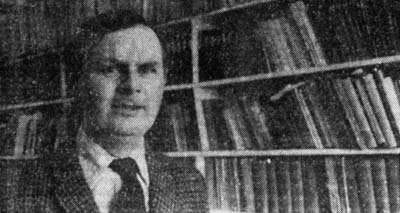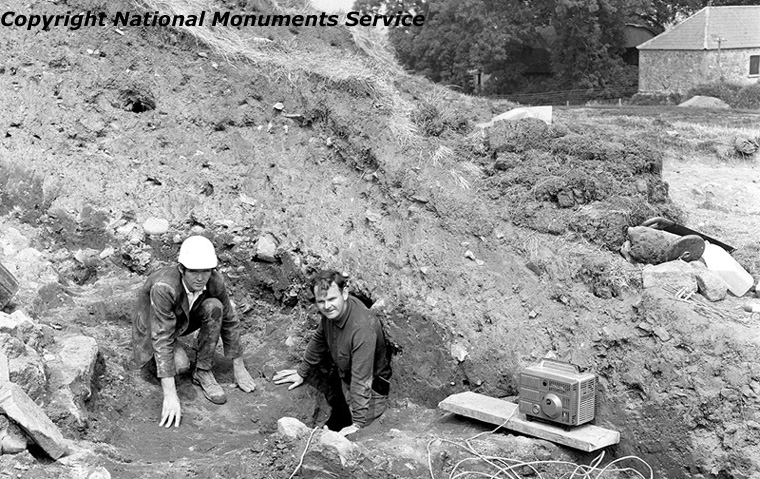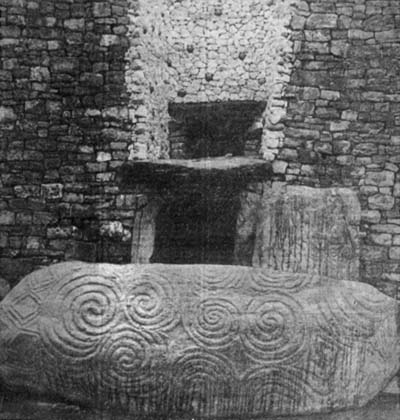Digging into the roots of the rich and varied Boyne Culture
An article by Mairead Stokes printed in The Irish Times, 17 March 1984
"Taking features such as the overall design, architecture and building techniques, Knowth has clearly demonstrated the intellectual sophistication of these early farming families of the Boyne Valley area." Professor George Eogan.
Think of the ancient culture of the northern African continent and you think of Egypt: think of Egypt and then the massive influence of the Nile predominates. The fertility of its banks gave us the pyramids, Tutankhamen and lots more besides.
Ireland does not have the Nile, but as archaeologists pursue their studies in County Meath, revealing new and exciting discoveries, the Boyne Valley of the Neolithic period emerges as an entity internationally known as the "Boyne Culture."
Much of the research there has centred on the area where the Boyne flows around a natural prominence. This, called the Bend of the Boyne, is probably the legendary Brugh na Bóinne where, it was said, kings were buried before the time of Cormac Mac Art, the grandson of Conn of the Hundred Battles.
The three most prominent sites in the area are passage graves, high round mounds or tumuli over burial chambers. Of these, Newgrange is now reconstructed to its original style of almost 5,000 years ago. Dowth stands as a reminder of the sad fate of many of our field monuments as it was mutilated over the centuries, then "excavated" in 1857 and later used as a quarry. Knowth however, is being systematically excavated, and to date has produced about 250 decorated stones, half of the total of all known Irish passage grave megalithic art, more than all France possesses and twice as much as can be found in Spain and Portugal together.
Professor Eogan of University College, Dublin, started the present excavation of Knowth in 1962, and through wet and dry summers since then, local men and cub-archaeologists have worked with him in what has turned out to be a very important if complicated site.
The special significance of the Knowth excavation lies in the fact that the site was used for Neolithic habitation as well as burial; was subsequently used by the Beaker, Early Bronze Age people; used as a cemetery about the early first millennium A.D. and shortly later as a settlement area which was protected by two extremely deep ditches which had been dug into the mound.
Knowth came to a new prominence about the 8th century when the kings of the region, the Kings of Northern Brega were called the Kings of Knowth. Remains of their extensive settlement consists of ten houses, ten souterrains, fire places, paved areas, iron-smelting and bronze and enamel-working areas along with ample evidence for corn-growing and domestic animals. The site was made even more complicated, archaeologically speaking, because some of the souterrains were built economically into the already existing passage of the Neolithic grave.
Knowth became the centre of activity again when the Normans set about the conquest of Meath as they used the Knowth main mound for a motte-and-bailey and built a rectangular stone building on its summit. Peace came to Knowth when the Normans left and when from the 12th century Mellifont Abbey was able to use the area as a grange.
George Eogan's purpose in excavating this Boyne site was principally to research undifferentiated Passage Graves or megalithic tombs consisting of a round mound over a chamber which has no clear differentiation between the burial chamber and the entrance passage. The cumbersome title, undifferentiated passage grave shows that there was little or no research done on this type of grave until recently.
Indeed, Professor Eogan's discovery of such a grave type immediately on top of a Neolithic habitation site in 1960-61 was the first time in which a Neolithic dating was suggested for such tombs in Ireland. That was in Eogan's excavation of a site in nearby Townleyhall.

John Rock and George Eogan at the opening to the passage of the Eastern tomb at Knowth in August 1969
Around the large tumulus at Knowth there were some features such as slight evidence for the presence of large stones which Professor Eogan believed might, on excavation, prove to be tombs. However, what started as research work on small sites turned into a mammoth work of studying the Boyne culture and systematically excavating over seven acres.
Professor Eogan was well qualified for this undertaking. Apart from that Townleyhall excavation he had worked with the late Paddy Hartnett on the now beautifully conserved Fourknocks passage grave near Naul, Co Meath. He had experience of excavating vast sites by working on Middle Eastern sites, notably the city of Petra in Jordan, with the British School of Archaeology in Jerusalem.
Knowth turned out to be a much richer site than could ever have been imagined. To George Eogan's satisfaction he found a cemetery of passage graves including examples of the undifferentiated variety. He found that the latter pre-and post-dated the major tomb.
However, his most dramatic discovery was that the main tumulus had a passage and chamber of the undifferentiated form as well as the form which was considered as the conventional Irish passage grave of cruciform-shaped chamber and a passage.
As these two types co-existed under the same large mound they confirmed Professor Eogan's Townleyhall findings of Neolithic dating for undifferentiated passage graves. To the surprise of many the radio-carbon determination from the Boyne site pushed back the dates for the existence of the passage grave people in Ireland to about 3,000 B.C.
The Board of Works has now purchased extra land here and have already completed conservation on some of the excavated sites. It is working on some of the other sites at present preparatory to opening the whole cemetery to the public.
Considering that Newgrange, which was purposely less extensively excavated than Knowth, and has fewer decorated stones visible, gets 70,000 visitors annually, then tourist prospects should be good when Knowth is added to the Brugh na Bóinne itinerary.
The excavation at Knowth revealed much about the passage grave builders a people who, it is generally accepted were the second major group of settlers of this country in the Neolithic period.
From his excavation, particularly of the large tumulus and a study of the art, Professor Eogan suggests that this Boyne culture people had a sophisticated, ordered society and were of a sufficiently large population to provide surplus food for the grave builders. That large tumulus which is a sizable 90 metres diameter and 11 metres high was built of alternating layers of sod, loose stones, shale and boulder clay laid blanket fashion over the site yet thickened towards the centre.
As there was no evidence for lengthy delays between laying each layer, it appears that the whole tumulus was built in one operation rather than as haphazard work over centuries. Such builders and architects/designers must have been specialists, and that in itself suggests that a distinctive social system had evolved which must have been based on a concentration of habitation or townships.
These Boyne people, Professor Eogan says, were intelligent as can be seen from the construction and the cemetery plan as well as the fact that they could find, identify and move boulders weighing several tons of selected stone type from areas north and south of the Boyne.
Their art is another clear indicator of their intelligence: it is non-representational, based on ziz-zags, circles, spirals, chevrons, triangles etc; but the decoration is obviously planned within the frame of the boulder shape. The boulders used for decoration are usually green grit. This art must have had special significance for the builders as there is a concentration of decorated stones to indicate the passage entrance, the chamber entrance and the chamber itself.
The fact that the nearby Newgrange cemetery plan, the construction of its mound, the cruciform-shaped chamber with its high corbelled roof and the megalithic art all bear similarities to Knowth but are distinctly different suggest that these two great tombs and cemeteries were built by different communities who nevertheless belonged to the same culture.
Professor Frank Mitchell of Trinity College points out that this area of Meath is a rich glacial plain and as the weather was about three degrees Celsius warmer in the third millennium B.C., that it would have been relatively easy for a local farming community to thrive.
It has been suggested in the past that this Boyne culture evolved from a sophisticated semi-urban civilisation which developed in the Iberian peninsula before 3,000 B.C. They buried their dead in collective chamber tombs.
It is accepted by many that this passage grave civilisation spread from Iberia to Brittany and then to the Boyne, Scotland and possibly Denmark. Yet even in this scenario it is accepted that the most notable complex of passage graves in Europe is at the Boyne where the prominent tombs are the focal points in a large necropolis. Professor Eogan points out that although there is a kinship between the Irish and Breton passage graves in tomb plans, megalithic art and predominance of cremation burial yet many of the grave goods from the Boyne sites and those from the other later Irish passage graves are distinctly different.
The Irish tombs, unlike the Breton and Iberian tombs, have Carrowkeel-type pottery, hemispherical pots of coarse ware profusely decorated in linear or "stab and drag" style. Other grave goods such as clay balls and bone or stone pendants also show an Irish character.
Only one small area of Neolithic habitation has been found in this through excavation. Surprisingly the pottery found there showed a kinship with that of the court tomb culture which has a mainly northern distribution here. Another kinship with that court tomb people was an area of flint-knapping activity.
Considering the problems solved and questions raised by the Knowth excavation and the importance of that site now in European archaeology the final publication of the findings of the Knowth excavation is awaited with much interest. The fist volume of a projected three volume report is due for publication shortly. It will appear as the first of a new series of archaeological monographs which will be published by the royal Irish Academy.
This new series, which as been given subvention from UNESCO and the Board of Works, should greatly help and even enhance the study of archaeology. Unusual in archaeology, this first volume will have a summary of the excavation in the Irish language. The publication of this volume will coincide with a special exhibition of the Knowth excavation material which will be held in the Arts Block University College, Dublin in the near future. Apart from his academic work Professor Eogan deserves credit for his encouragement of a popular interest in Irish archaeology. When he discovered the passages in the main tumulus at Knowth he shared his excitement immediately with the general public a practice which few archaeologists considered previously.
Having excavated the area since 1962 it is not surprising that Professor Eogan is now preparing for his last few seasons. This coming summer he and his team hope to excavate the great eastern tomb and to start more comprehensive work on the western tomb of the main tumulus. A daunting task, which was given due reward last year when a superbly decorated flint macehead was discovered after 45 centuries.
What will this year's prize be?
Boyne Valley Private Day Tour
 Immerse yourself in the rich heritage and culture of the Boyne Valley with our full-day private tours.
Visit Newgrange World Heritage site, explore the Hill of Slane, where Saint Patrick famously lit the Paschal fire.
Discover the Hill of Tara, the ancient seat of power for the High Kings of Ireland.
Book Now
Immerse yourself in the rich heritage and culture of the Boyne Valley with our full-day private tours.
Visit Newgrange World Heritage site, explore the Hill of Slane, where Saint Patrick famously lit the Paschal fire.
Discover the Hill of Tara, the ancient seat of power for the High Kings of Ireland.
Book Now


